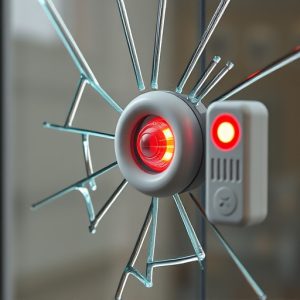Secure Your Space with Smart Glass Break Alarm Sensors: Installation, Maintenance, and Advanced Features
Glass break alarm sensors are critical components for modern security systems, designed to detect th…….
Glass break alarm sensors are critical components for modern security systems, designed to detect the specific sound frequencies emitted by breaking glass and trigger an immediate alarm. These sensors can be microphone-based or utilize digital analysis algorithms to differentiate glass fracture sounds from other noises. They are effective in protecting against intrusions, alerting occupants to potential breaches, and enhancing overall property security beyond just physical barriers. Proper installation near windows or doors at heights clear of ambient noise, regular testing to account for environmental factors like construction or traffic, and maintenance checks including battery verification and firmware updates are essential for their optimal performance. Additionally, a UPS can be beneficial in areas with unstable power supplies. Regular cleaning, inspections, and adjustments ensure these sensors remain attuned to the acoustic signatures of glass breakage, minimizing false alarms and maintaining vigilance against unauthorized entry or security breaches. By combining precise technology with strategic placement and ongoing maintenance, glass break alarm sensors continue to be a reliable and integral part of comprehensive security solutions.
When it comes to safeguarding your home or business, a glass break alarm sensor serves as a pivotal component in your security system. This article delves into the intricacies of how these sensors function, offering valuable insights into their detection mechanisms and operation. We’ll guide you through the installation process and provide maintenance tips to ensure your glass break alarm sensor operates at its best. Additionally, we’ll explore advanced features that can enhance the effectiveness of your security system, ensuring you stay ahead of potential threats. Understanding and utilizing a glass break alarm sensor effectively is key to maintaining a secure environment, and this article is designed to equip you with the knowledge needed for optimal protection.
Understanding Glass Break Alarm Sensors: Detection Mechanisms and Operation
Glass break alarm sensors are a critical component in security systems, designed to detect the sound of breaking glass and trigger an alarm. These sophisticated devices utilize advanced technology to differentiate between the frequencies emitted by the shattering of glass and ambient noise. Upon activation, they emit a piercing alert, signaling potential intrusion or hazard. The sensors are tuned to recognize the specific acoustic signature of glass breakage, which typically involves a combination of high-frequency sounds that fall within a certain decibel range.
The operation of these sensors relies on either a physical microphone or a digital analysis system. Physical microphones are positioned near windows or doors and are highly sensitive to the sound patterns associated with breaking glass. Digital systems, on the other hand, analyze the audio environment using algorithms that can distinguish between glass breakage and other noises. Once the sensor identifies an acoustic event matching the criteria for glass breakage, it sends a signal to the security system’s control unit, which then triggers the alarm. This rapid response capability is crucial in deterring criminal activity or alerting occupants to an emergency situation such as a natural gas leak where glass may be broken unintentionally. Glass break alarm sensors are integral in enhancing the overall security of residential and commercial properties, providing an additional layer of defense beyond physical barriers.
Installing and Maintaining Your Glass Break Alarm Sensor for Optimal Security
Installing a glass break alarm sensor is a critical step in enhancing your home or business security. These sensors are designed to detect the sound frequencies emitted by breaking glass, triggering an alarm and deterring potential intruders. To ensure proper installation, follow the manufacturer’s instructions carefully. Typically, sensors should be placed near vulnerable windows or doors, at a height that allows for optimal detection range without capturing ambient noise. Once installed, test the sensor regularly to confirm its functionality. Environmental factors such as construction, nearby traffic, or HVAC systems can affect its performance, so it’s important to conduct routine checks. Additionally, keep the sensor clean and free of dust or debris that could interfere with its sensitivity. Regular maintenance includes checking batteries, if the sensor is battery-operated, and verifying connections and wiring for any signs of wear or damage. By adhering to these installation and maintenance practices, you can rest assured that your glass break alarm sensor will serve as a reliable layer of defense against unauthorized entry.
Maintaining your glass break alarm sensor involves more than just occasional tests; it requires consistent care and attention to detail. To ensure the sensor operates at peak efficiency, regularly inspect its components for any signs of damage or dislodgment. If the sensor is affected by power fluctuations, consider using an uninterruptible power supply (UPS) to prevent false alarms during outages. Update your system’s firmware when new versions are released, as these updates can improve performance and security features. Document any adjustments made to the sensitivity settings or changes in the environment that could impact the sensor’s functionality. Proactive maintenance can help you address issues before they lead to malfunctions. Regularly review your security system’s log files to identify patterns or anomalies, which can inform any necessary calibrations or repositioning of the sensor. With diligent care and a proactive approach to maintenance, your glass break alarm sensor will remain a vigilant guardian against potential glass breaks and security breaches.
Maximizing Effectiveness: Advanced Features and Best Practices for Glass Break Alarm Systems
Glass break alarm sensors are an integral component of modern security systems, designed to detect the sound of breaking glass and trigger an alarm. To maximize their effectiveness, it’s crucial to integrate sensors that feature advanced technology such as frequency analysis algorithms capable of distinguishing between the sound of glass breaking and other sounds. These sophisticated sensors can be tuned to recognize specific patterns and frequencies associated with broken glass, minimizing false alarms from construction work, fireworks, or other loud noises.
Installation placement is another key factor in ensuring a glass break alarm sensor’s effectiveness. Sensors should be positioned strategically around the perimeter of windows and doors, as well as in areas prone to vandalism or forced entry. Additionally, maintaining the sensor’s sensitivity settings according to the ambient noise levels can significantly reduce nuisance alarms. Regular testing and maintenance are essential to confirm that the system is functioning correctly and to adjust sensitivity as needed. Adhering to these best practices alongside the utilization of advanced technology in glass break alarm sensors ensures a robust layer of security for any property.


